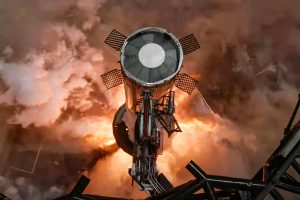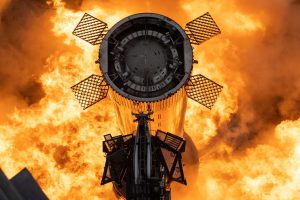More than three months after the building-sized Starship booster’s latest return to Starbase’s orbital launch site, SpaceX has finally begun the process of testing what CEO Elon Musk says is still the first flightworthy Super Heavy.
After completing a number of pad tests in the days prior, SpaceX began filling Super Heavy Booster 4 (B4) with liquid nitrogen – supplied by the first orbital-class Starship launch – for the first time on December 17th. It’s unclear exactly what was done during the test but regardless of what transpired, the test and B4’s survival were a major, long-awaited milestone for both the Starship booster and the orbital launch site (OLS).
At this point in time, the general consensus among close followers of SpaceX’s Starship program is that the unprecedented amount of time it’s taken the company to complete Booster 4’s first test was not because of the rocket itself but rather because the orbital launch site needed to fully test it had yet to be completed. While it was SpaceX’s choice to not perform some kind of initial testing with B4 at one of the site’s two suborbital test and launch mounts, it’s clear that the company ultimately concluded that Super Heavy Booster 3’s successful July 2021 tests – including a cryogenic proof virtually identical to Booster 4’s first test – made such partial testing redundant.
Put a different way, SpaceX must already be confident enough in the quality of the first few Super Heavies rolling out of its Starbase factory to deem it unnecessary to verify the structural integrity of the first truly completed Super Heavy booster before putting the one and only orbital Starship launch site directly in the line of fire. Nonetheless, depending on how far Super Heavy Booster 4’s first cryogenic proof test went, it appears that SpaceX’s presumptions were correct.
On December 17th, SpaceX subjected Super Heavy B4 to a cryogenic proof test about twice as ambitious as B3’s, filling the booster maybe a sixth of the way with a few hundred tons of liquid nitrogen (LN2). What isn’t clear is if that test also raised the booster’s propellant tanks to flight pressures (6-8 bar or 90-115 psi). If Booster 4 did reach those pressures, the test is even more significant – partially proving that the rocket is ready for flight. On December 21st, SpaceX performed a similar series of cryogenic tests, again partially filling Booster 4 with about the same amount of liquid nitrogen but doing so two or three times in a row. Again, the Super Heavy survived the several-hour ordeal without any obvious issues. Still, a number of additional tests – some even more important – are still in front of SpaceX and Super Heavy B4.
The most obvious is simple enough: SpaceX needs to fully fill a Super Heavy booster for the first time. Depending on the storage situation, that process will likely begin by filling Booster 4 with about 2500 tons (5.5M lb) of liquid nitrogen (LN2) – about two-thirds full. If SpaceX also temporarily fills one of the orbital tank farm’s liquid oxygen (LOx) or methane (LCH4) tanks with nitrogen, it could fully load Booster 4 with around 3500 tons (7.7M lb) of nitrogen. At least according to SpaceX’s own website, that’s about the same weight as the propellant (3400t/7.5M lb) Super Heavy is designed to lift off with. If that full cryoproof goes well, SpaceX will then likely perform one or several wet dress rehearsals, ultimately filling Booster 4 with approximately 2900 tons (6.4M lb) of cryogenic oxygen and 500 tons (1.1M lb) of cryogenic methane.
Finally, SpaceX will probably kick off static fire testing, likely beginning by igniting just one or a few of Super Heavy’s many engines. Eventually, that process could culminate in the ignition of all 29 of Booster 4’s Raptors, briefly producing a bit less than 5400 tons (~11.9M lbf) of thrust – 50% more powerful than NASA’s retired Saturn V Moon rocket.
According to Elon Musk, despite a number of recent signs and reports to the contrary, SpaceX still intends to fly Booster 4 and Ship 20 on Starship’s first orbital-velocity launch attempt, so the scope and scale of testing are only likely to grow over the next several weeks.





